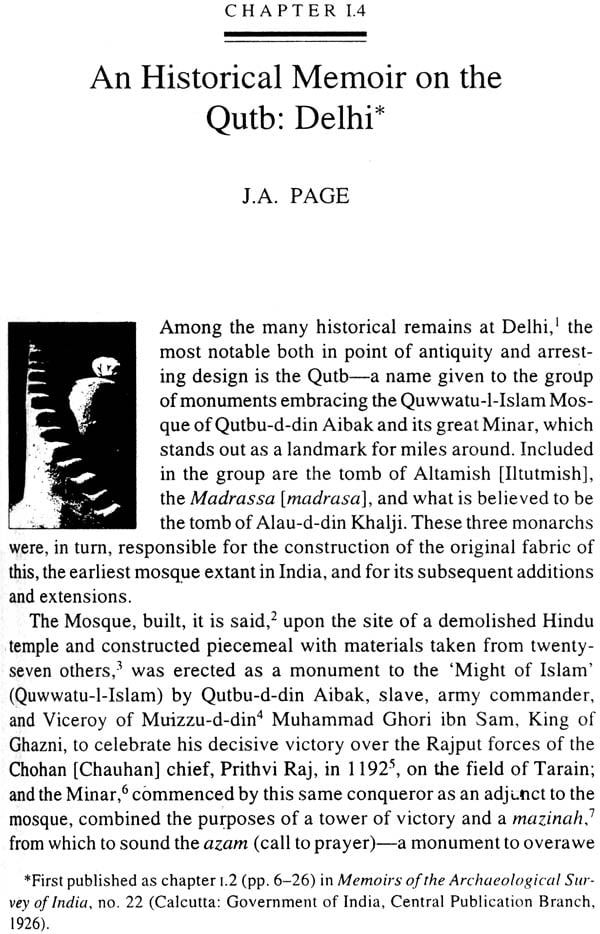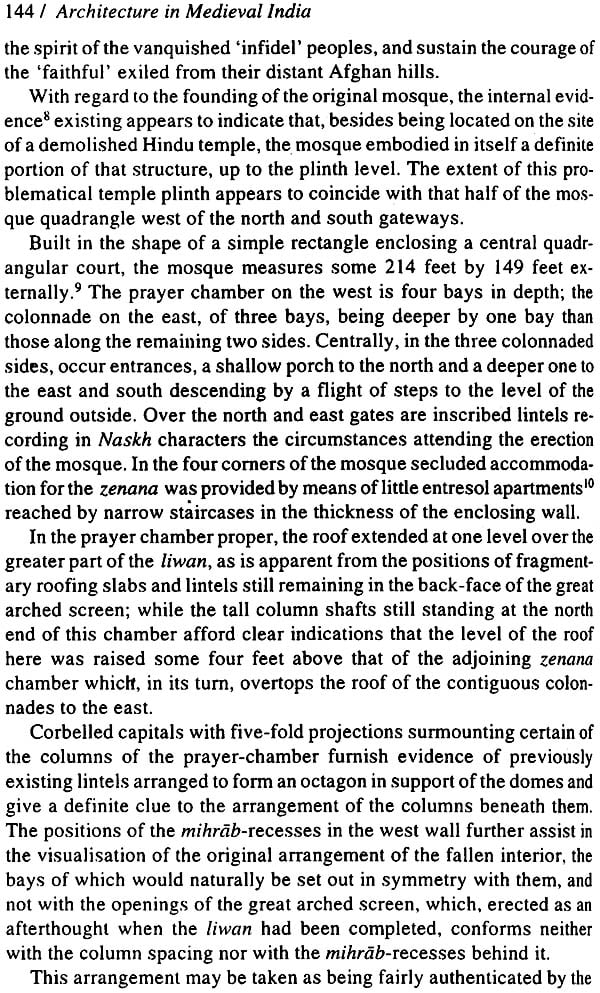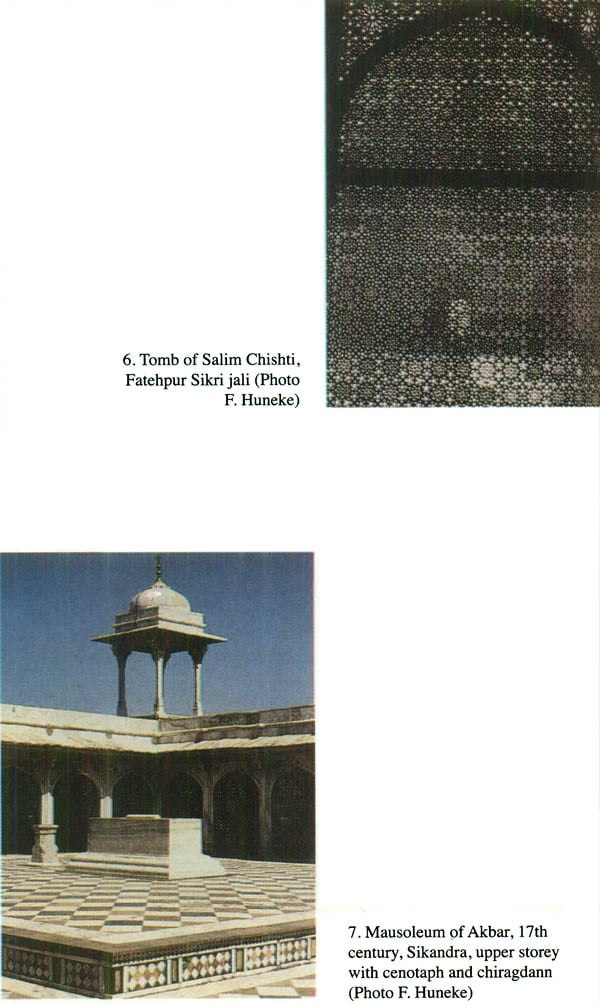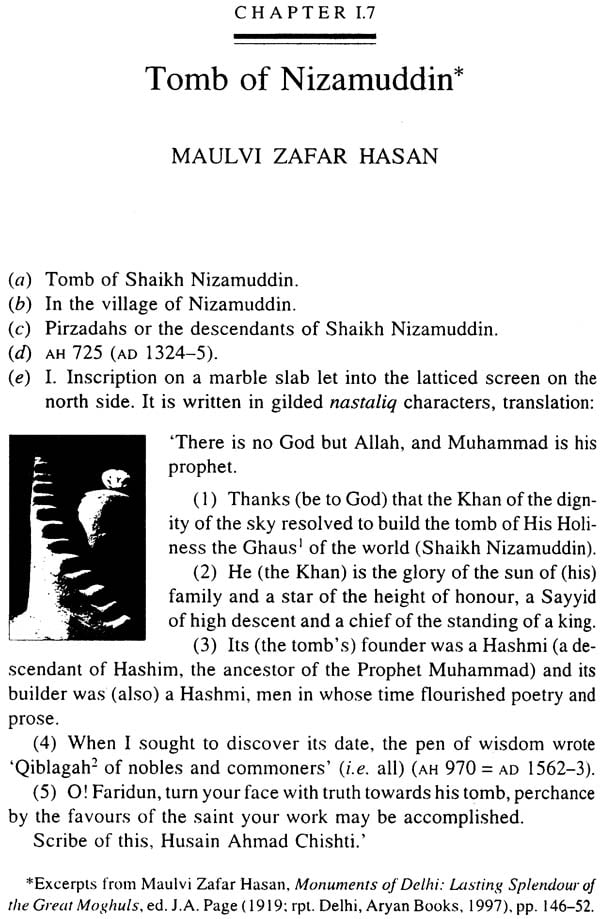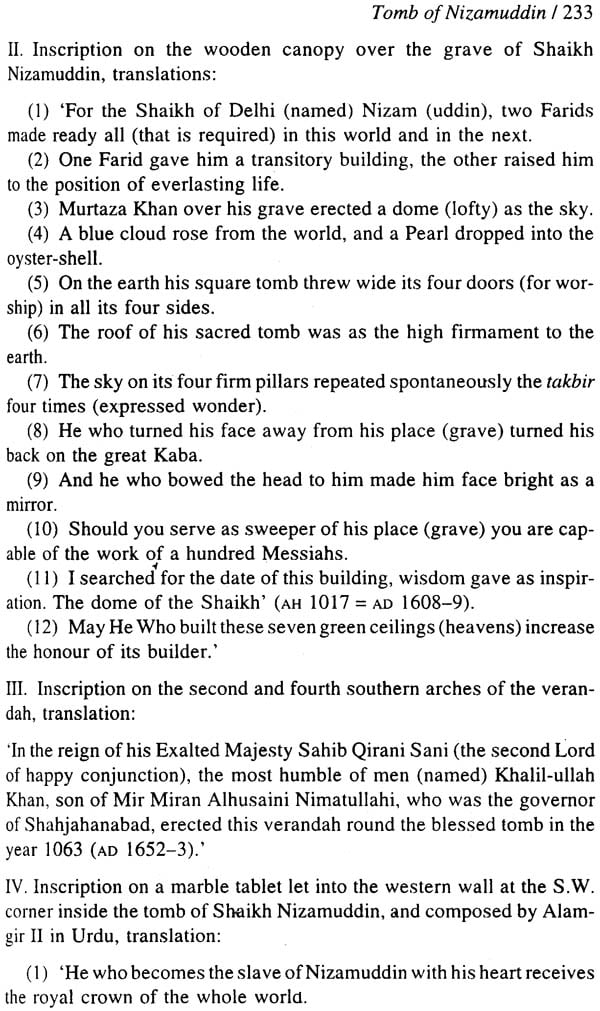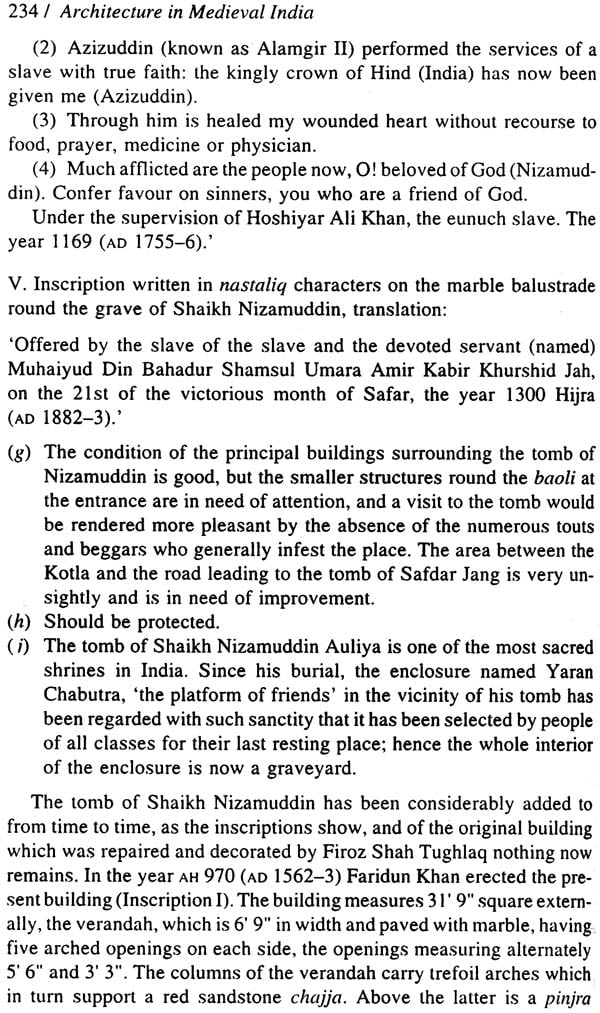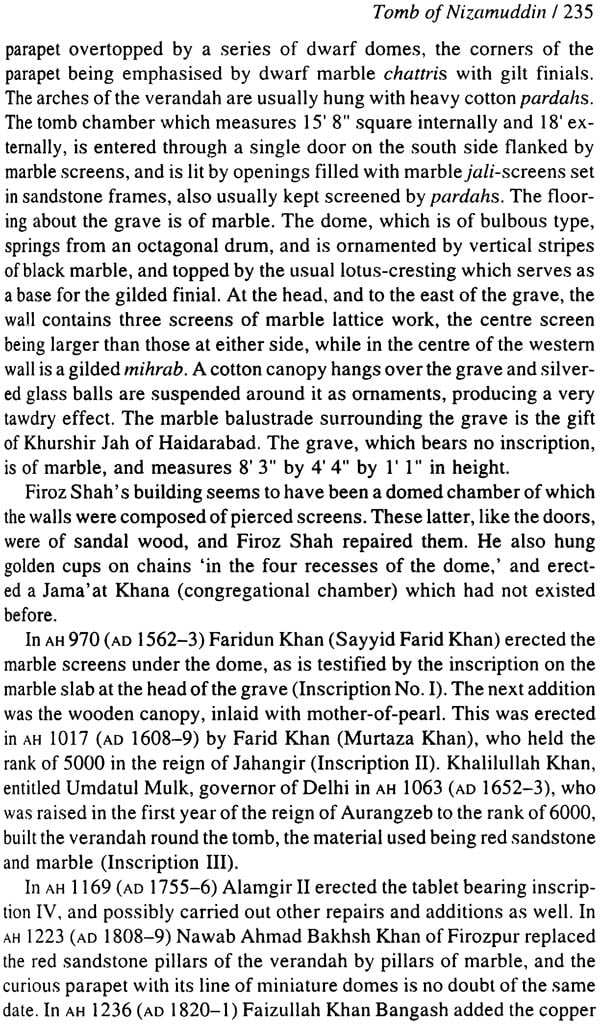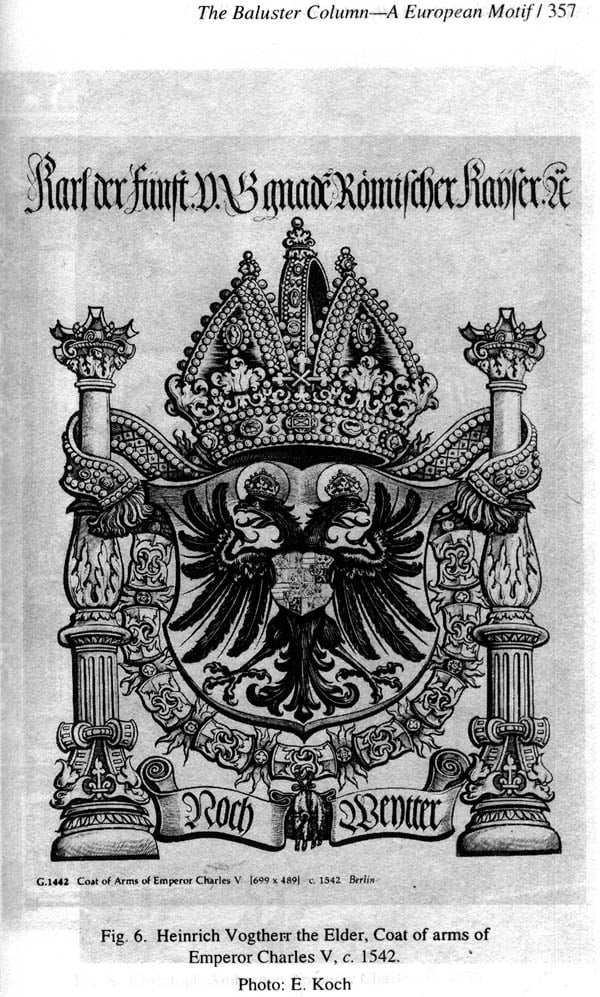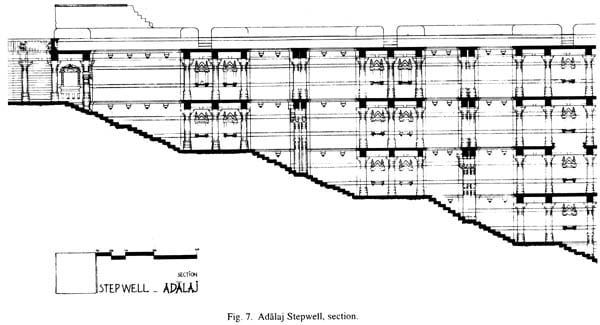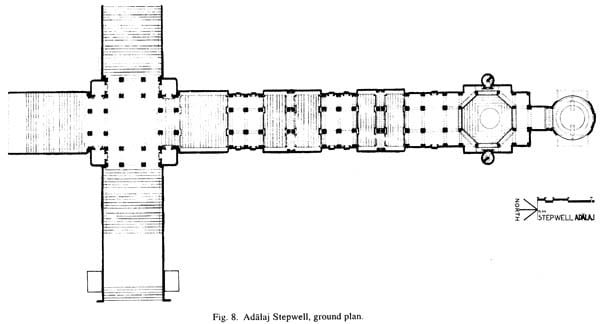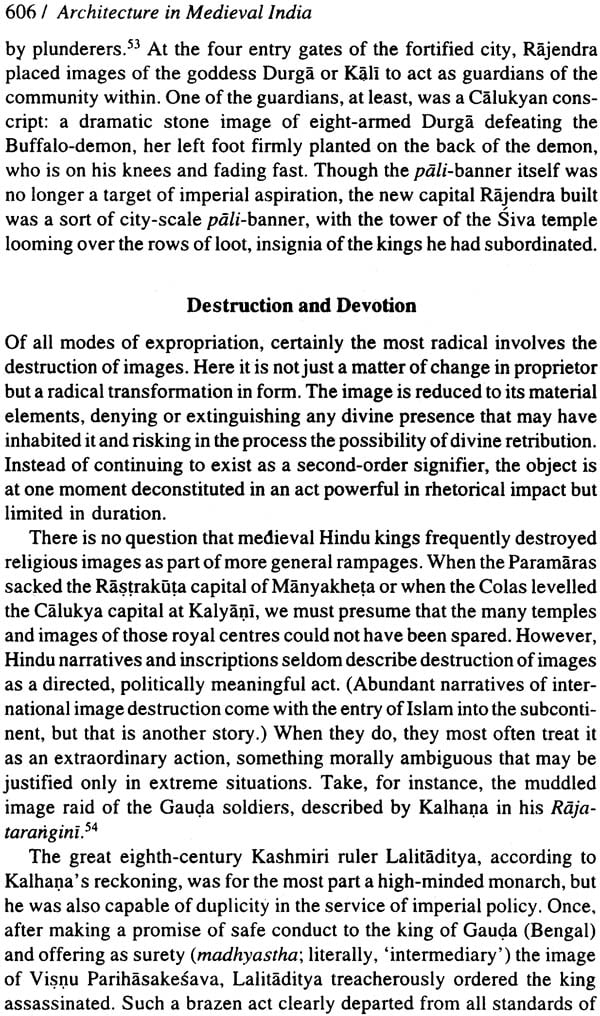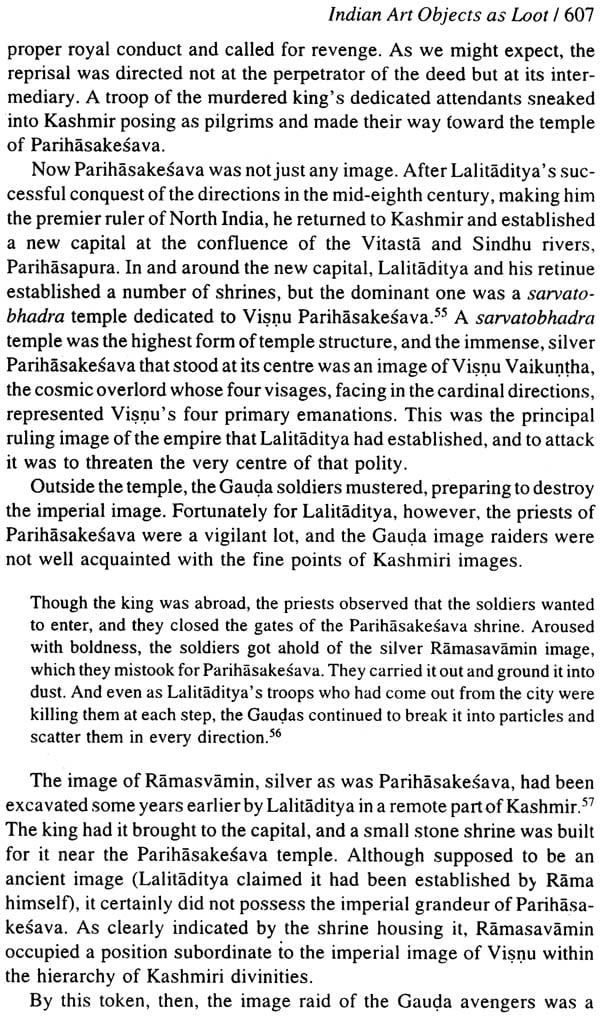
Architecture In Medieval India
Book Specification
| Item Code: | NAG212 |
| Author: | Monica Juneja |
| Publisher: | Permanent Black |
| Language: | English |
| Edition: | 2012 |
| ISBN: | 9788178242286 |
| Pages: | 656 (10 colors and 60 B/W Illustrations) |
| Cover: | Paperback |
| Other Details | 8.5 inch X 5.5 inch |
| Weight | 640 gm |
Book Description
About the Book
The architectural history of medieval India has been the subject of very diverse writings. The present book pulls together the most significant of these, revealing an impressive array of ideas about India s past through the study of its monuments.
A long Introduction examines the intellectual importance of architectural history, showing how buildings and their histories have frequently been polemical and instrumental: they have been politically deployed to construct or fabricate a past.
They have been used to provide symbolic meanings which have helped subjugate or unify heterogeneous communities and nations. The architectural history of India s misnamed Muslim period is revealed as the site of tensions between Hindus and Muslims, colonialists and nationalists, traditionalists and postmodernists. The writings reproduced here are also located within the specific intellectual, political, and socio cultural contexts within which they emerged, making this reader a major contribution to Indian history.
About the Author
MONICA JUNEJA has been Professor, Department of History, University of Delhi. She is currently based in Vienna and gives lectures on art history at universities in Austria, Germany, and the USA. Introduction
MONICA JUNEJA
Architecture is the knowledge of how to go about using housed and mansions for cover and shelter. This is because man has the natural disposition to reflect upon the outcome of things. Men must protect their community by surrounding it with a wall to guard them. The whole thing thus becomes a single town or city. Architecture is also needed when rulers and people of a dynasty build towns and high monuments. They try their utmost to make good plans and build tall structures with technical perfection so that [architecture] can reach its highest development. Ibn Khaldun, the Muqaddimah: An Introduction to History, trans. Franz Rosenthal, Princeton 1967.
In the house of God, which presupposes the existence of a living community, the congregation fulfills the task of establishing connections. The congregation which assembles [here] for prayer and worship, outgrows the imperfection of communal life, not in order to overcome it, but to keep it alive in thought and to repeatedly integrate it within a state of tension. Through the edification of the congregation, the community perpetually renews itself, and this elevation above the everyday keeps the everyday from going under. Siegfried Kracauer, Das Ornament der Masse: Essays, Frankfurt/M 1963 60.
To the fourteenth century historian Ibn Khaldun, the functional aspects of architecture made it, together with agriculture, tailoring and weaving, a necessary craft in any sedentary civilization. He did not fail to perceive that these uses were both physical and social: building creates spaces which demarcate and separate, it constitutes units, defines group and community from others. Like the wall of China in Kafka s story which united the people into a ring of brothers, built structures served to bond those protected by them. By generating feelings of allegiance and solidarity, they were understood as physical manifestations of social and political order.
Separated from Ibn Khaldun by over five centuries and vast cultural distance, Siegfried Kracauer, the German architect and cultural theorist, viewed architectural space as a medium to understand society: within it the realities of the everyday and their suspension exist in a state of dialectical tension, enabling communities to attain a heightened consciousness of self, as individual, group and collectivity. Architectural space forms a space of encounter, or imagining, of belonging, and equally a space of transcendental homelessness, as Kracauer characterized some of the spaces of modernity, notably that of a hotel lobby. If the understanding of architecture has at times seemed trapped within questions of form per se, it had also, as these disparate examples suggest, for long been able to transcend the limitations of such a frame. These are some of the issues this collection seeks to address: the varying trajectories followed by writings on the architectural history of medieval India; the ways in which studies of forms and contexts have been cast and recast in these histories; and finally, the possibilities of revitalization within the discipline as it stands today.
This volume traces the development of the discipline of the architectural history of medieval India by situating a range of writings from the mid nineteenth century to the present day in the contexts where in they emerged and were elaborated; by calling into question the intellectual and cultural factors that impinged on these writings; and by examining their implications for present and future research. A certain self reflexivity in which the choi8ce of theoretical perspectives and methodological strategies has been fore grounded informs the orientation of this enterprise. It is rooted in my own particular understanding of the subject: that of an art historian anchored within the discipline of history.
This book forms part of a larger effort to remove art forms from the realm of the exotic, and of purely aesthetic value judgments themselves historically constituted and to bring them back into the centre of history. It locates the study of architecture within a larger field of socio cultural history: what constitutes this field has been shaped by developments in historical studies during the last three decades or so. The notion of culture has now been radically recast within a mould which joins it to question of power. It seems no longer plausible to accept culture as something shared by all members of a society. Rather, we understand it as something constitute through, or fractured by, differences of class, gender and ethnicity. Moreover, the claim of coherence and internal consistency within culture in others words, culture read as a system of symbols or structure of relations has given way to a conceptualization which sees culture as a plurality of discourses and practices coexisting within a dynamic field of interaction and contestation. 6 To what extent, then, is it possible to situate a study of the cultural forms that proliferated during the centuries designated the medieval period of Indian history within such a field, where hegemonies were continually being constituted, contested and transformed? Can the study of medieval architecture, in particular, be read as integral to histories of power and domination, of conquest and state formation, of movements of men and women, ideas and traditions? Can we recover some of the ways in which the structures and spaces of the built environment participated in the dynamics of conflict and coexistence, of processes of exclusion and assimilation that marked relationships between the subcontinent s communities and socio religious groups?
These are some of the concerns crucial to the study of artistic forms, political symbols and the acts of persuasion built into them in medieval India. It is unfortunate, however, that the growing body of historical writings on medieval polities, economy, and religious cults and movements, remains confined within artificially created disciplinary straitjackets. This shortcoming applies equally to much of the existing writing in the field of art history. For a long time the landscape of historical research on medieval India was dominated by historians collectively designated as the Aligarh School. A proliferation of writings during the 1960s and the 1970s did make a significant breakthrough inasmuch as they introduced structural factors and quantitative methods as analytical categories to furnish explanations that would effectively counter communalist approaches to the study of Indian history. Working within a somewhat simplistic Marxist framework which relegated cultural practice to a superstructure that reflected the ideological programme of the ruling elites, histortians of Aligarh largely bypassed the study of architecture. 9 Implicit in many of their writings was an understanding of culture which came close to nationalist approaches, in that it postulated the notion of a peaceful synthesis of the traditions of Hinduism and Islam, both assumed to form homogeneous, monolithic entities, a synthesis which in the field of architecture, could be read as a visual translation of the syncretic politics of emperors such as Akbar and Shah Jahan. Such an understanding, unaccompanied by scholarly attempts to historicise the study of forms, has continued to exercise a persuasive power among present day adherents of a so called secular nationalism, especially in the contemporary context of resurgent fundamentalisms.
Today, while another generation of historians has begun rethinking the history of medieval India and amorphous lack of certainties characterizes this field studies. Most contemporary historical enterprises remain trapped within a myopic understanding of state systems and politics. This refusal to engage with the rich and diverse histories of architectural creations of these centuries is tantamount to denying that power itself is culturally shaped, that political processes extend beyond the spheres of state institutions and organisations and are inscribed within a variety of settings and textures of everyday life within a niche of their making, concerned primarily with question of forms and sources. Examples of attempts by these two streams to reach out to each other are still few and far between.
Any attempt to situate the study of architecture at the crossroads of a history of culture, society and politics must, however, be equally rooted within the particularities of architecture as a form of artistic cum scientific production in which the iconic, the spatial, the functional and the technical come together. In other words, the centrality of forms and techniques to understanding the ways in which architectural creations are embedded in larger discourses and practices needs to be recognized. Exploring the myths and fictions which inform a political order, for instance, involves analyzing how these fictions are invented and perpetuated, the strategies and dynamics of the rhetoric that render them persuasive and long lasting. The very form given to a genre of aesthetic production oral or written, in manuscript of in print, painted or built belongs to the reflexive dimension of all representation, that is, it embodies the modalities by which an object or a structure is able to represent something else, how it becomes a text. Representation, according to Marin, involves a cluster of operations of adaptation and classification that produce the many configurations by which reality is perceived, constructed and represented. These practices and forms make certain identities recognizable, they exhibit and signify relationships, status, rank, the coherence of a community, the force of an individual, the permanence of a power. Marin s writings help the historian comprehend more fully the workings of the social world, for they point to the ways in which confrontations based on violence and brute force change into symbolic struggles centred on representations. Forms and images become readable as texts of power because they bring about a substitution of the external manifestation in which a force appears, only to annihilate another force, bearing the signs or rather signals and indications that need only be seen, noted, shown, then narrated and recounted in order for the force from which they emanated to be believed .
Inversely, the act of production, of bringing a structure or a complex into being, inscribes in its forms, spaces and textures its relation to the fundamental structures that, at a given moment and place, fashion the distribution of power as well as the organization of society and economy. Building activity is as much a socio administrative act: it involves the control of an apparatus necessary to plan and design, to mobilize resources and labour, to organize the quarrying and transportation of building material. In the monarchical polities of medieval India, patronage itself was a significant act: it spelt power, not only economic and political, but equally ideological the potential to create utopian ideals of monarchy, to simulate the powers of God. The architectural remains of these societies which form the subject of this collection were a product of the patronage, royal and noble, invariably required for enterprises at that mammoth scale. At one level, as we know, patronage and the creation of such structures were intrinsic to ideologies of power. Plans, designs, and iconic forms all drew upon traditions and languages of a high culture, at times articulated in complex, self consciously constructed aesthetic cum philosophical treatises or statements, but more often through the forms and styles themselves. They formed part of a culture supported and propagated by the state and powerful institutions, in other words a dominant or hegemonic culture of social and political elites. Yet, to what extent is it legitimate to view this culture as autonomous, as existing in a pure form? The Endeavour to write a broader history of medieval Indian architecture would involve paying equal attention to modalities of uses and appropriations of buildings and forms, to processes of construction of meaning, to seeing the connections between practices and representations. The location of building within a nexus of urban complexes, as also their use by large numbers of individuals, introduced a varied cultural baggage within this nexus. This included the cultures of non elite groups which would have brought in an everyday culture of work, belief and ritual, caste and gender relations through all of which such groups was themselves as particular communities and engaged with others. Thus the meanings generated around the site of a building were necessarily heterogeneous. The multilayered complexity of such a culture undermines the assumption that architectural activity can be read as creating distinct cultural objects belonging to an elite alone; therefore the activity demands different modes of analysis. Both interpretive and reconstructive techniques, still a largely unexplored terrain in medieval Indian studies, are needed for a non reductive investigation of the history of meaning at all levels. The search for such techniques rests on the premise that a range of diversely structured codes create the multiple meanings of almost every building be it public or ceremonial, courtly, ritualistic or domestic in even the most self consciously ideological and aesthetically refined art effects of high culture.
New nations, it would appear, need ancient pasts. According to Pierre Nora, modern memory relies to a great extent on the materiality of traces, on the visibility of images. Architecture, a central referent in efforts to invent collective memories, comes to be indissociably linked with notions of heritage and identity. The built environment has often been deployed to construct identities, to stress the sameness of individuals who are in fact embedded in multiple and complex social configurations. At the same time, buildings acquire a past through narratives created by historians about them, narratives centring on their origins, construction, symbolic apparatus and uses. This implies a discursive use of architectural remains to build collective pasts that generate feelings of stability, continuity, exclusiveness or belonging, these emotions being necessary to particular social configurations in particular historical contexts, and involving in ventions and reinventions, concerted containment, elisions and forgetting, that is what Benedict Anderson describes as collective amnesia. In the context of medieval India, for instance, the invention of a collective past as embodied in its architectural vestiges has often been achieved either through the singling out of individual stylistic threads Buddhist, Hindu, Islamic or Jain from an intricate patchwork quilt, or else by viewing the whole as a well knit, cohesive unit, effacing either way the rich historicity of that past. Buildings and their histories, as a result, have become a site of conflict and tension within political culture. This in turn impinges on the directions chalked out by the discipline of architectural history. These are issues which have come to bear on the trajectories followed by a number of writings on medieval Indian architecture, and which this anthology attempts to address.
The history of architecture as the discipline we know today came into being during the colonial period. The earliest writings in this field were located in specific political and cultural contexts of power, in both colony and metro pole. Their pioneering achievements, while providing copious empirical and documentary material for subsequent studies, left a seemingly indelible stamp on many of the preoccupations and perspectives of more modern historians. The relatively large sample of writings from this period reprinted in this volume testifies to the prolific character of colonial histories of Indian architecture and ought to help the reader gauge their enduring influence.
Contents
| Acknowledgements | x | |
| List of Illustrations | xi | |
| List of Copyrights | xvi | |
| Introduction Monica Juneja | 1 | |
| Section I: Indigenous Initiatives, Colonial Aesthetics, Nationalist Views | ||
| I.1 | Asar as Sanadid | 109 |
| I.2 | Indian Saracenic Architecture | 120 |
| I.3 | Indian Architecture | 133 |
| I.4 | An Historical Memoir on the Qutb: Delhi | 143 |
| I.5 | Monuments of the Mughul Period | 171 |
| I.6 | The Qudsia Bagh at Delhi: Key to Late Mughal Architecture | 219 |
| I.7 | Tomb of Nizamuddin | 232 |
| I.8 | Mosque of Shaikh Abdu n Nabi | 239 |
| I.9 | Symbolism of the Dome | 244 |
| I.10 | A Family of Great Mughal Architects | 279 |
| I.11 | The Qutub Complex as a social Document | 290 |
| Section II: Imperial forms, Regional structures | ||
| II.1 | The Two and a Half Day Mosque | 303 |
| II.2 | From Tamerlane to the Taj Mahal | 315 |
| II.3 | The Baluster Column A European Motif in Mughal Architecture and its meaning | 328 |
| II.4 | New light on the history of two early mughal monuments of Bayana | 362 |
| II.5 | The architecture of raja man singh: A study of sub-imperial patronage | 370 |
| II.6 | Royal architecture and imperial style at vijayanagara | 398 |
| II.7 | The architecture of baha al-din tughrul in the region of bayana, Rajasthan | 413 |
| II.8 | Temple niches and mihrabs in Bengal | 439 |
| II.9 | Ancient Asian building techniques in Hindu and Muslim structures of the vijayanagara Empire and in subsequent Indo-Islamic monuments | 456 |
| Section III: The architecture of everyday life | ||
| III.1 | Characteristics of a Stepwell | 473 |
| III.2 | Four mughal caravanserais built during the reigns of Jahangir and Shah Jahan | 527 |
| III.3 | The city as an image of the king: some notes on the town-planning of Mughal capitals in the sixteen and seventeen centuries | 541 |
| III.4 | Hanging gardens in the princely capitals of Rajasthan and in renaissance Italy: sacred space, Earthly paradise, secular ritual | 549 |
| Section IV: Art and Politics | ||
| IV.1 | Sources and Determinants of the Architecture at Fatehpur Sikri | 563 |
| IV.2 | Indian Art Objects as Loot | 584 |
| Glossary | 614 | |
| Bibliography | 623 |
